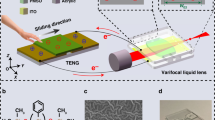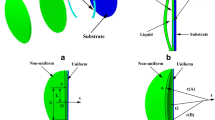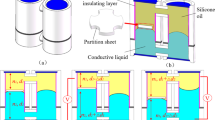Abstract
This paper reports on a detailed deformation model of varifocal liquid lenses fabricated by Parylene-on-liquid-deposition (POLD), which can be applied to measure and adjust the focal length of such lenses without using extra sensors or sensing mechanisms. The lens was fabricated by encapsulating a liquid between a transparent electrode and a polymer film that was covered with a metal electrode. When voltage is applied to the two electrodes, the lens deforms due to the electrostatic force, and its focal length and the capacitance between the two electrodes change simultaneously. This characteristic enables the focal length of the lens to be adjusted and detected by measuring the capacitance change. The focal length of the fabricated varifocal liquid lens changed from 153.6 to 82.6 mm by applying 150-V. The focal length change of the liquid lens was calculated from the change in its capacitance. Finally, to confirm the efficiency of this varifocal liquid lens, we fabricated a confocal distance sensor using the lens for laser scanning and demonstrated that this system can be used to measure distances of 94–140 mm with an average error of 0.83 mm and a standard deviation of 0.77 mm.











Similar content being viewed by others
References
Y. Kim, J.S. Lee, A.W. Morles, S.J. Ko, A video camera system with enhanced zoom tracking and auto white balance. IEEE Trans. Consum. Electron. 48(3), 428–434 (2002)
C.S. Liu, P.D. Lin, P.H. Lin, S.S. Ke, Y.H. Chang, J.B. Horg, Design and characterization of miniature auto-focusing voice coil motor actuator for cell phone camera applications. IEEE Trans. Magn. 45(1), 155–159 (2009)
J.A. Conchello, J.W. Lichtman, Optical sectioning microscopy. Nat. Methods 2(12), 920–931 (2005)
M. Figl, C. Ede, J. Hummel, F. Wanschitz, R. Ewers, H. Bergmann, W. Birkfellner, A fully automated calibration method for an optical see-through head-mounted operating microscope with variable zoom and focus. IEEE Trans. Med. Imag. 24(11), 1492–1499 (2005)
Y. Shao, D.L. Dickensheets, P. Himmer, 3-D MOEMS mirror for laser beam pointing and focus control. IEEE J. Sel. Top. Quant. Electron. 10(3), 528–535 (2004)
R. Hokari, K. Hane, Micro-mirror laser scanner combined with a varifocal mirror. Microsyst. Technol. 18, 475–480 (2012)
S.W. Lee, S.S. Lee, Focal tunable liquid lens integrated with an electromagnetic actuator. Appl. Phys. Lett. 90, 121129 (2007)
N.T. Nguyen, Micro-optofluidic lenses: a review. Biomicrofluidics 4, 031501 (2010)
N. Binh-Khiem, K. Matsumoto, I. Shimoyama, Polymer thin film deposited on liquid for varifocal encapsulated liquid lenses. Appl. Phys. Lett. 93(12), 124101 (2008)
A. Pouydebasque, C. Bridoux, F. Jacquet, S. Moreau, E. Sage, D.S. Patrice, C. Bouvier, C. Kopp, G. Marchand, S. Bolis, N. Sillon, E.V. Blanc, Varifocal liquid lenses with integrated actuator, high focusing power and low operating voltage fabricated on 200 mm wafers. Sensor Actuator Phys. 172, 280–286 (2011)
S. Kuiper, B.H.W. Hendriks, Variable-focus liquid lens for miniature cameras. Appl. Phys. Lett. 85, 1779954 (2004)
Y.J. Chang, K. Mohseni, V.M. Bright, Fabrication of tapered SU-8 structure and effect of sidewall angle for a variable focus microlens using EWOD. Sensor Actuator Phys. 136, 546–553 (2007)
X. Hu, S. Zhang, C. Qu, Q. Zhang, L. Lu, X. Ma, X. Zhang, Y. Deng, Ionic liquid based variable focus lenses. Soft Matter 7, 5941–5943 (2011)
C. Li, H. Jiang, Electrowetting-driven variable-focus microlens on flexible surfaces. Appl. Phys. Lett. 100, 231105 (2012)
L. Dong, A.K. Agarwal, D.J. Beebe, H. Jiang, Adaptive liquid microlenses activated by stimuli-responsive hydrogels. Nature 442, 551–554 (2006)
X. Zeng, C.T. Smith, J.C. Gould, C.P. Heis, H. Jiang, Fiber endoscopes utilizing liquid tunable-focus microlenses actuated through infrared light. IEEE ASME J. Microelectromech. Syst. 20(3), 583–593 (2011)
G.A. Topasna, Capacitance of spherical dielectric layers. Appl. Phys. Lett. 100, 024501 (2011)
Acknowledgments
This work was supported by the Japan Science and Technology Agency (JST). The photomasks were made by using the University of Tokyo VLSI Design and Education Center’s (VDEC) 8-inch EB write F5112 + VD01 donated by ADVANTEST Corporation.
Author information
Authors and Affiliations
Corresponding author
Electronic supplementary material
Below is the link to the electronic supplementary material.
Rights and permissions
About this article
Cite this article
Noda, K., Binh-Khiem, N., Takei, Y. et al. Focal length measurement of a varifocal liquid lens with capacitance detection. Appl. Phys. B 115, 69–76 (2014). https://doi.org/10.1007/s00340-013-5574-3
Received:
Accepted:
Published:
Issue Date:
DOI: https://doi.org/10.1007/s00340-013-5574-3




